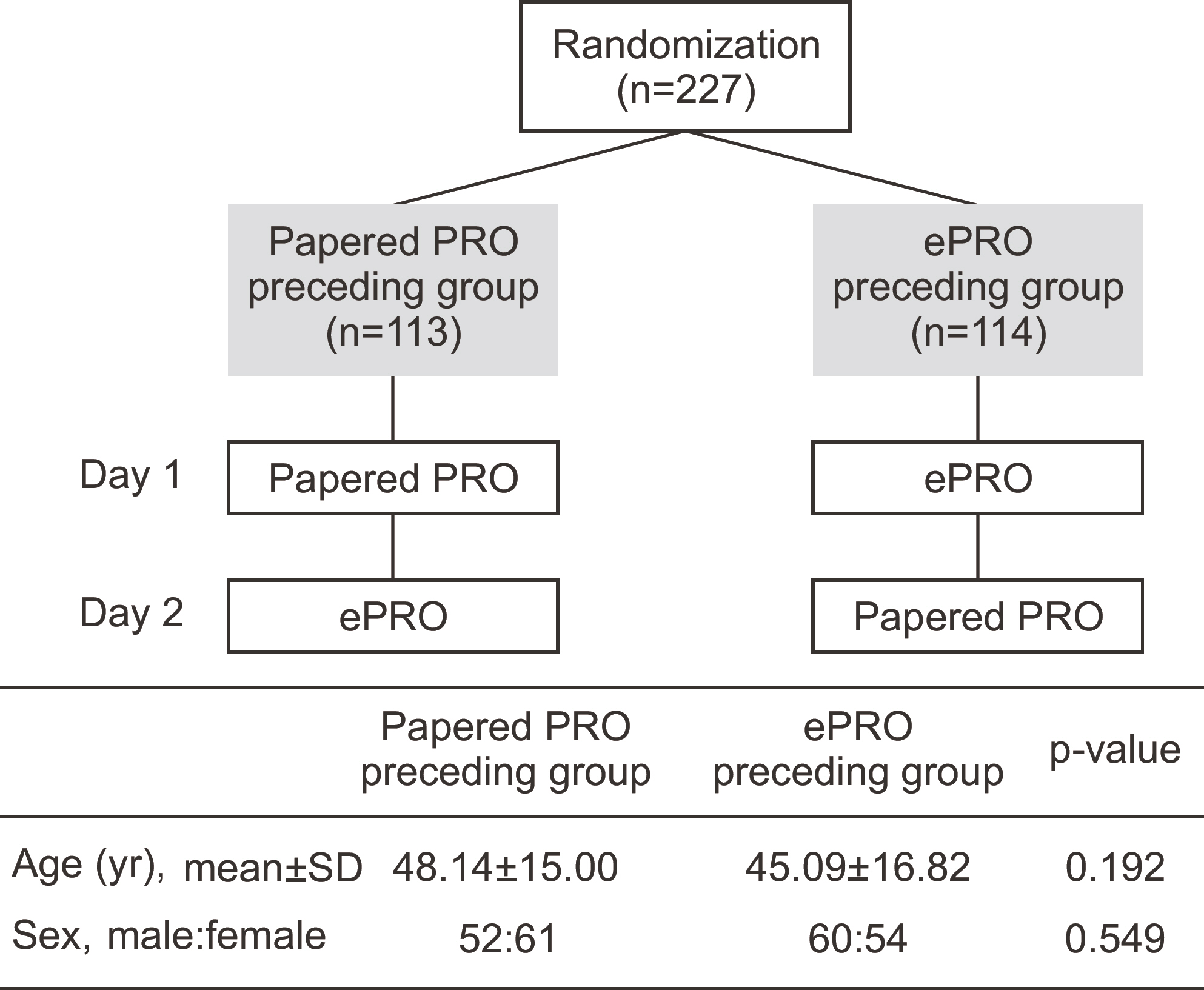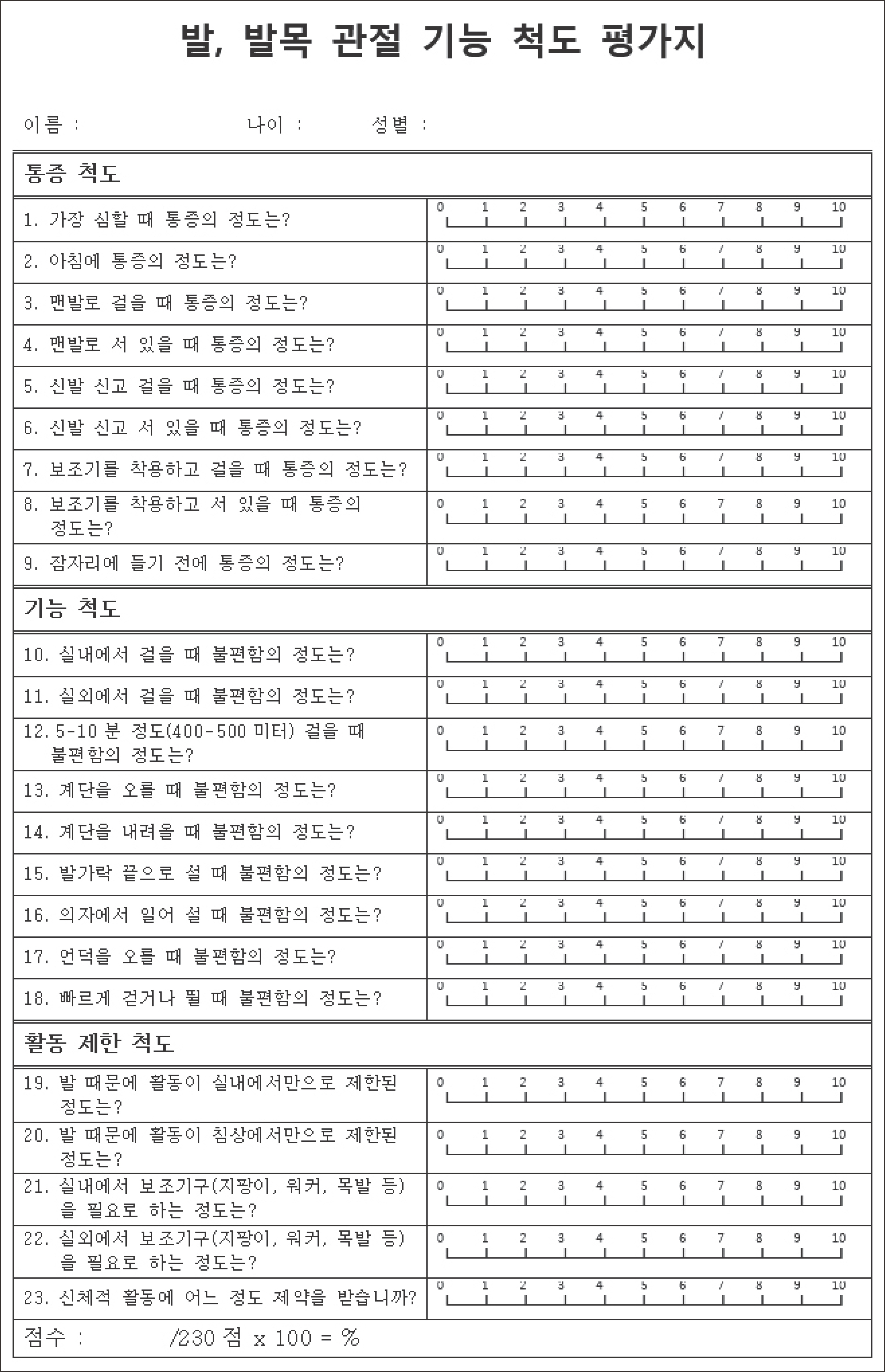J Korean Foot Ankle Soc.
2019 Mar;23(1):24-30. 10.14193/jkfas.2019.23.1.24.
Validation of Electronic Foot Function Index in Patients with Foot and Ankle Disease: A Randomized, Prospective Multicenter Study
- Affiliations
-
- 1Department of Orthopedic Surgery, Seoul National University Hospital, Seoul National University College of Medicine, Seoul, Korea.
- 2Department of Orthopedic Surgery, Wonkwang University Sanbon Hospital, Wonkwang University School of Medicine, Gunpo, Korea. castkim@hanmail.net
- 3Seoul Foot and Ankle Center, Dubalo Orthopedic Clinic, Seoul, Korea.
- 4Department of Orthopedic Surgery, Inha University School of Medicine, Incheon, Korea.
- 5Department of Orthopedic Surgery, Korea University Ansan Hospital, Ansan, Korea.
- 6Department of Orthopedic Surgery, Asan Medical Center, University of Ulsan College of Medicine, Seoul, Korea.
- 7Department of Orthopedic Surgery, Sun General Hospital, Daejeon, Korea.
- 8Department of Orthopedic Surgery, Kangbuk Samsung Hospital, Sungkyunkwan University School of Medicine, Seoul, Korea.
- 9Department of Orthopedic Surgery, St. Vincent's Hospital, College of Medicine, The Catholic University of Korea, Suwon, Korea.
- 10Department of Orthopedic Surgery, CHA Bundang Medical Center, CHA University School of Medicine, Seongnam, Korea.
- 11Department of Orthopedic Surgery, Myongji Hospital, Goyang, Korea.
- 12Department of Orthopedic Surgery, Chuncheon Sacred Heart Hospital, College of Medicine, Hallym University, Chuncheon, Korea.
- 13Department of Orthopedic Surgery, Seoul Hospital, Soonchunhyang University College of Medicine, Seoul, Korea.
- 14Department of Orthopedic Surgery, Kangnam Sacred Heart Hospital, College of Medicine, Hallym University, Seoul, Korea.
- 15Department of Orthopedic Surgery, Hallym University Sacred Heart Hospital, Anyang, Korea.
- KMID: 2440581
- DOI: http://doi.org/10.14193/jkfas.2019.23.1.24
Abstract
- PURPOSE
To evaluate the efficiency of the electronic foot function index (eFFI) through a prospective, random based, multi-institutional study.
MATERIALS AND METHODS
The study included 227 patients ranging in age from 20 to 79 years, visited for surgery in different 15 institutes, and agreed to volunteer. The patients were assigned randomly into a paper-based evaluated group (n=113) and tablet-based evaluated group (n=114). The evaluation was done on the day of hospital admission and the method was changed on the second day of surgery and re-evaluated. PADAS 2.0 (https://www.proscore.kr) was used as an electronic evaluation program.
RESULTS
There were no differences in age and sex in both groups. The intraclass correlation coefficient (ICC) evaluation revealed an eFFI ICC of 0.924, showing that both results were similar. The evaluation time was shorter in the tablet-based group than the paper-based group (paper vs tablet, 3.7±3.8 vs 2.3±1.3 minutes). Thirty-nine patients (17.2%) preferred to use paper and 131 patients (57.7%) preferred the tablet. Fifty-seven patients (25.1%) found both ways to be acceptable.
CONCLUSION
eFFI through tablet devices appears to be more constant than the paper-based program. In addition, it required a shorter amount of time and the patients tended to prefer the tablet-based program. Overall, tablet and cloud system can be beneficial to a clinical study.
MeSH Terms
Figure
Cited by 2 articles
-
Relationships Between Relative Ankle Muscle Ratios, Severity of Symptoms, and Radiologic Parameters in Adolescent Patients With Symptomatic Flexible Flat Feet
Youngju Shin, So Young Ahn, Soo-Kyung Bok
Ann Rehabil Med. 2021;45(2):123-130. doi: 10.5535/arm.20174.Patient-Reported Outcome Measures of the Foot and Ankle
Jiyoun Kim, Bom Soo Kim
J Korean Foot Ankle Soc. 2022;26(1):1-8. doi: 10.14193/jkfas.2022.26.1.1.
Reference
-
1.Gagnier JJ. Patient reported outcomes in orthopaedics. J Orthop Res. 2017. 35:2098–108.
Article2.Gwaltney CJ., Shields AL., Shiffman S. Equivalence of electronic and paper-and-pencil administration of patient-reported outcome measures: a meta-analytic review. Value Health. 2008. 11:322–33.
Article3.Coons SJ., Gwaltney CJ., Hays RD., Lundy JJ., Sloan JA., Revicki DA, et al. ISPOR ePRO Task Force. Recommendations on evidence needed to support measurement equivalence between electronic and paper-based patient-reported outcome (PRO) measures: ISPOR ePRO good research practices task force report. Value Health. 2009. 12:419–29.
Article4.Kim JB., Kwon MS., Kim JG., Yi Y., Lee WC., Ha JK, et al. The methods for foot function index and foot and ankle outcome score measurement: a comparison between paper-and-pencil method and electronic method. J Korean Foot Ankle Soc. 2017. 21:33–8.
Article5.In TS., Jung JH., Kim K., Jung KS., Cho HY. The reliability and validity of the Korean version of the foot function index for patients with foot complaints. J Phys Ther Sci. 2017. 29:53–6.
Article6.Budiman-Mak E., Conrad KJ., Roach KE. The foot function index: a measure of foot pain and disability. J Clin Epidemiol. 1991. 44:561–70.
Article10.Deyo RA., Andersson G., Bombardier C., Cherkin DC., Keller RB., Lee CK, et al. Outcome measures for studying patients with low back pain. Spine (Phila Pa 1976). 1994. 19(18 Suppl):2032S–2036S.
Article7.Yaffe M., Goyal N., Kokmeyer D., Merrell GA. The use of an iPad to collect patient-reported functional outcome measures in hand surgery. Hand (N Y). 2015. 10:522–8.8.Ioannidis JP., Greenland S., Hlatky MA., Khoury MJ., Macleod MR., Moher D, et al. Increasing value and reducing waste in research design, conduct, and analysis. Lancet. 2014. 383:166–75.
Article11.Zbrozek A., Hebert J., Gogates G., Thorell R., Dell C., Molsen E, et al. Validation of electronic systems to collect patient-reported outcome (PRO) data-recommendations for clinical trial teams: report of the ISPOR ePRO systems validation good research practices task force. Value Health. 2013. 16:480–9.
Article9.Dawson J., Fitzpatrick R., Carr A. Questionnaire on the perceptions of patients about shoulder surgery. J Bone Joint Surg Br. 1996. 78:593–600.
Article
- Full Text Links
- Actions
-
Cited
- CITED
-
- Close
- Share
- Similar articles
-
- Common Foot and Ankle Disease
- The Methods for Foot Function Index and Foot and Ankle Outcome Score Measurement: A Comparison between Paper-and-Pencil Method and Electronic Method
- Rehabilitation of Common Ankle and Foot Sports Injuries
- Prognostic Factors of Wound Healing after Diabetic Foot Amputation; ABI, TBI, and Toe Pressure
- Outpatient Management of Foot and Ankle Disease



